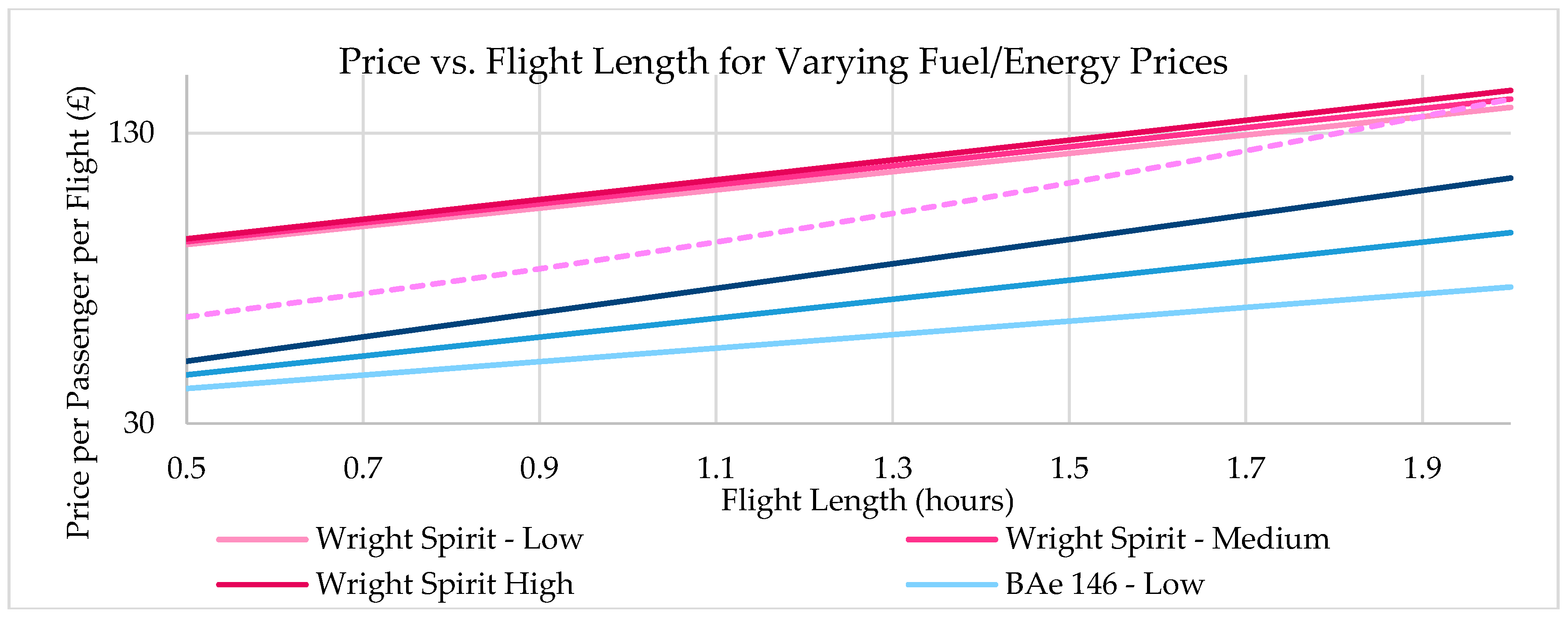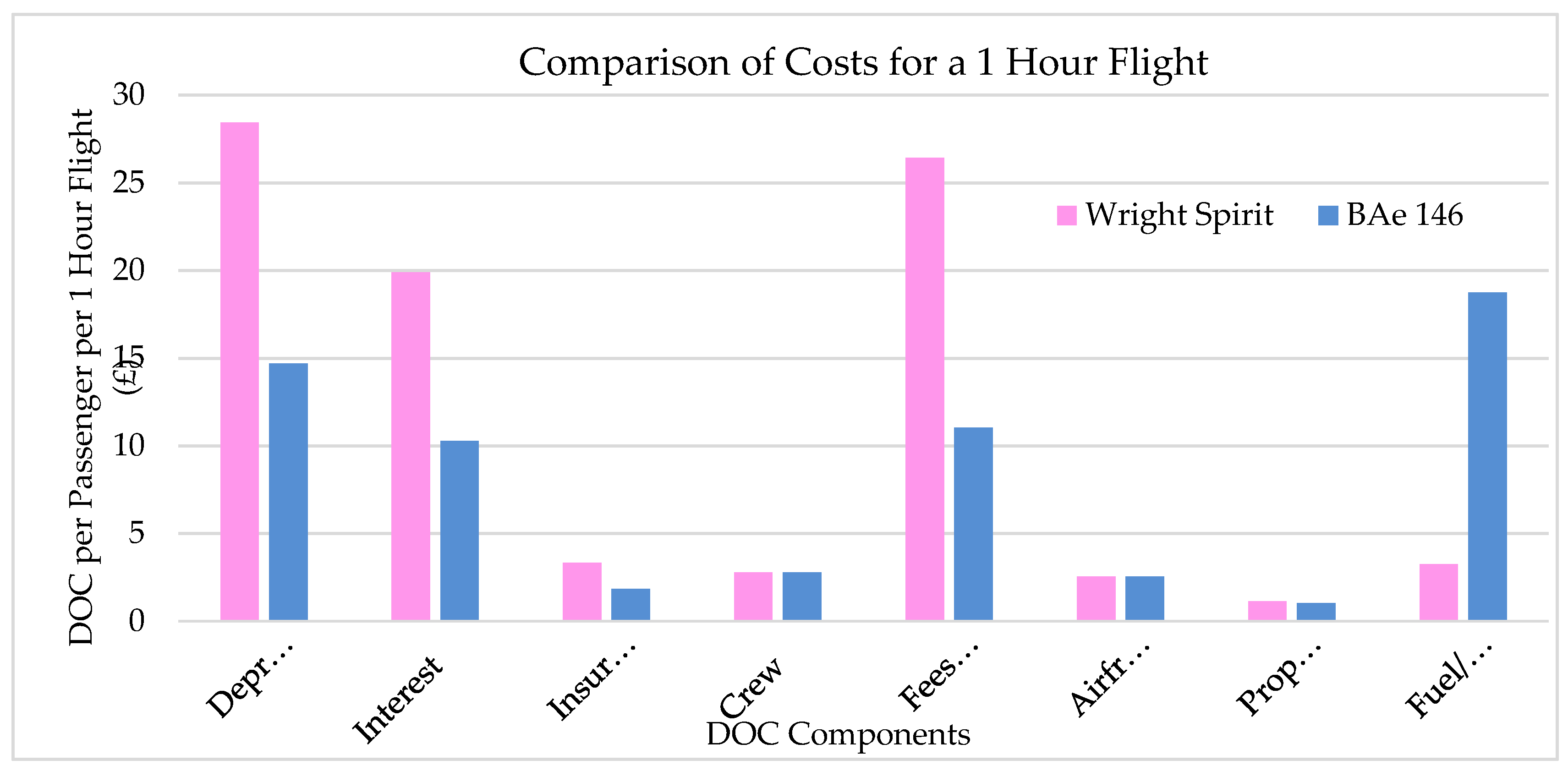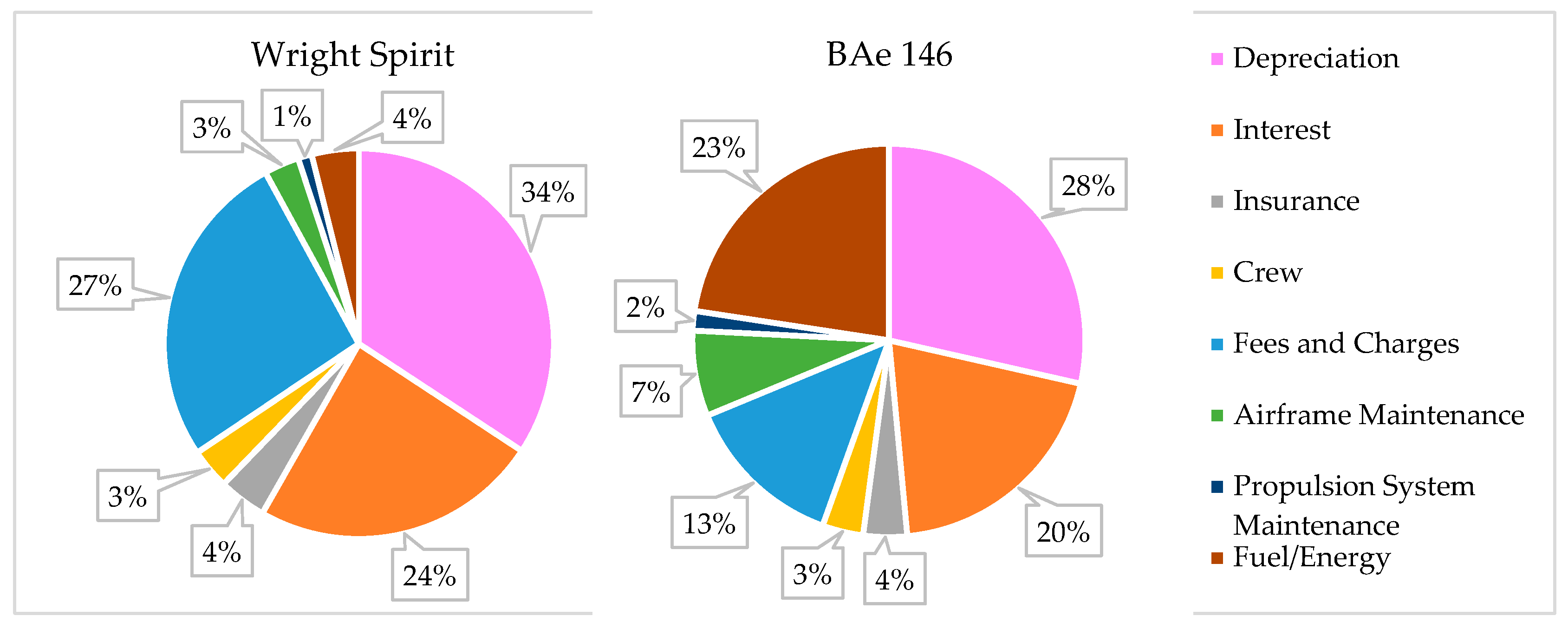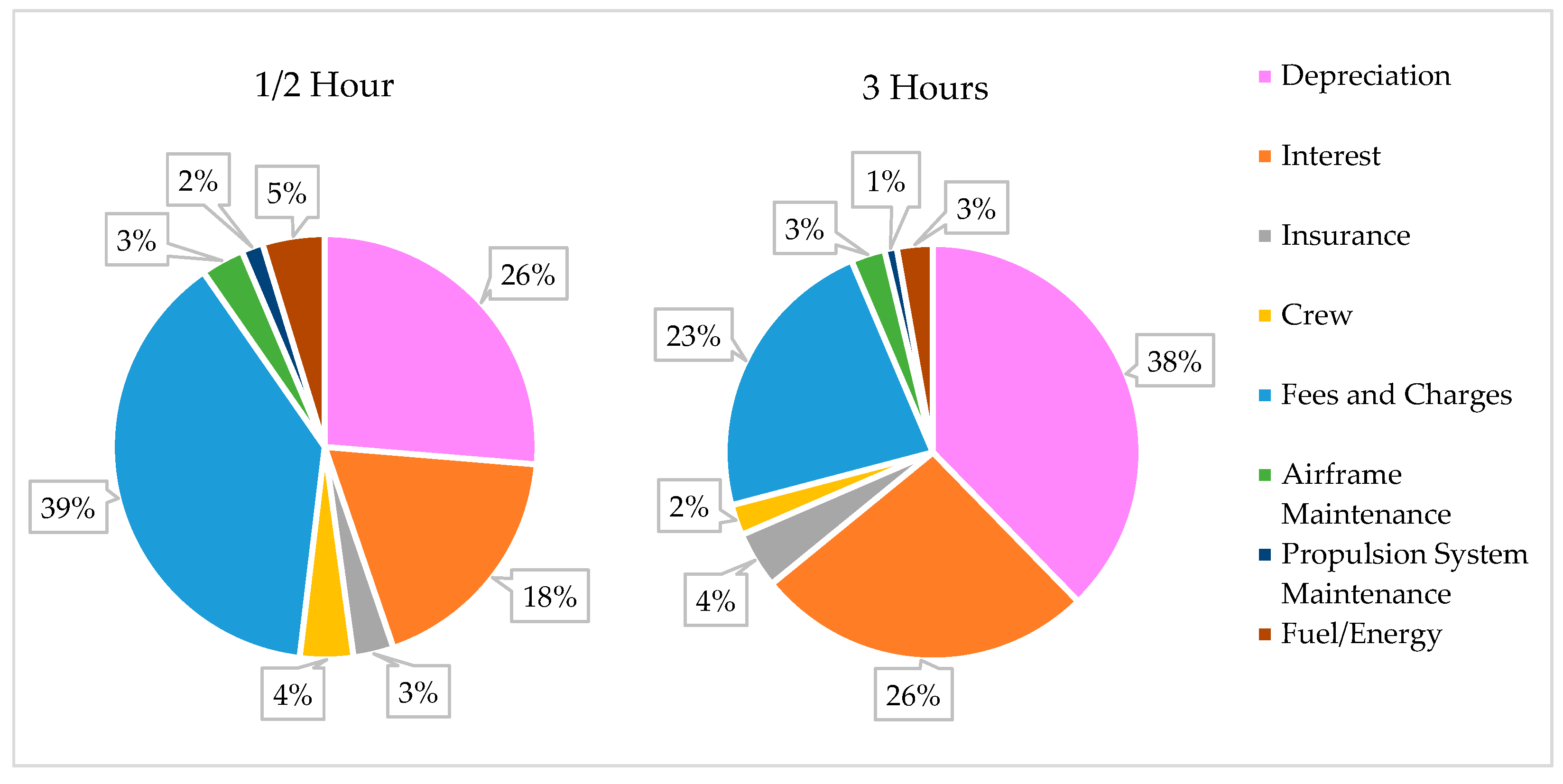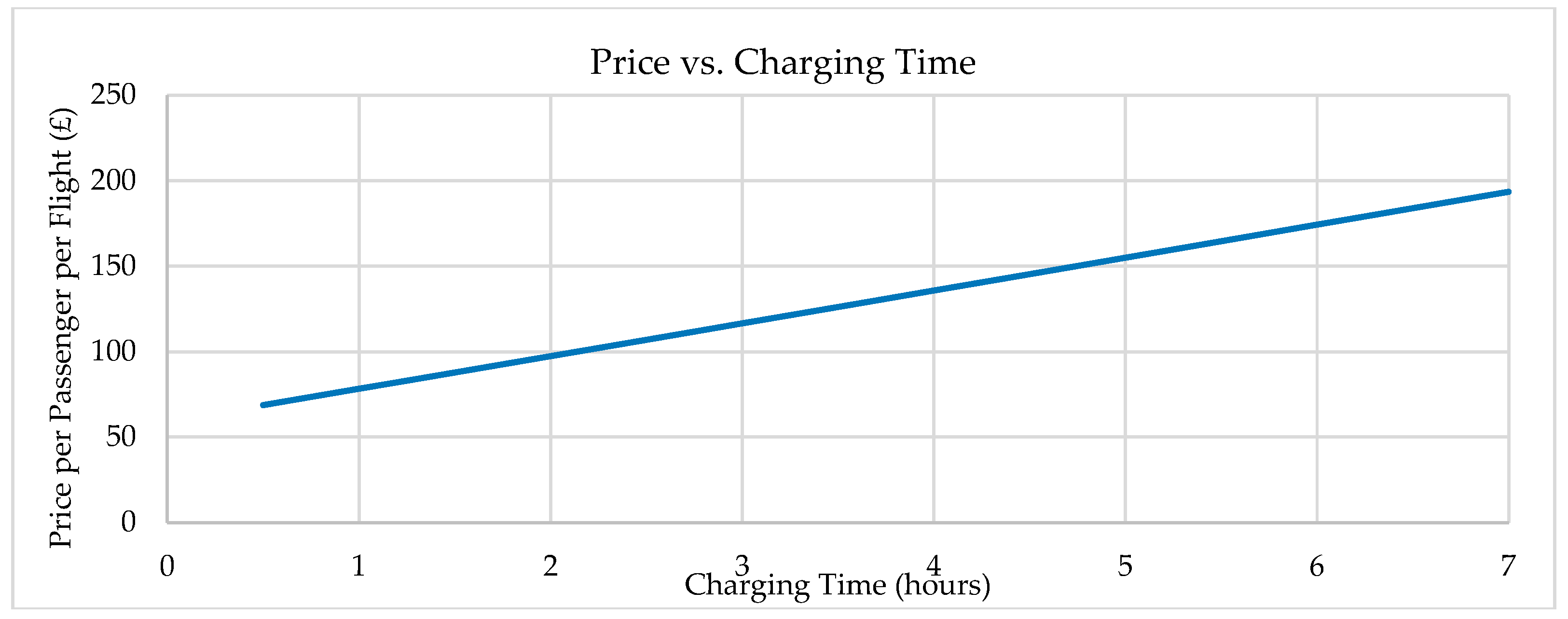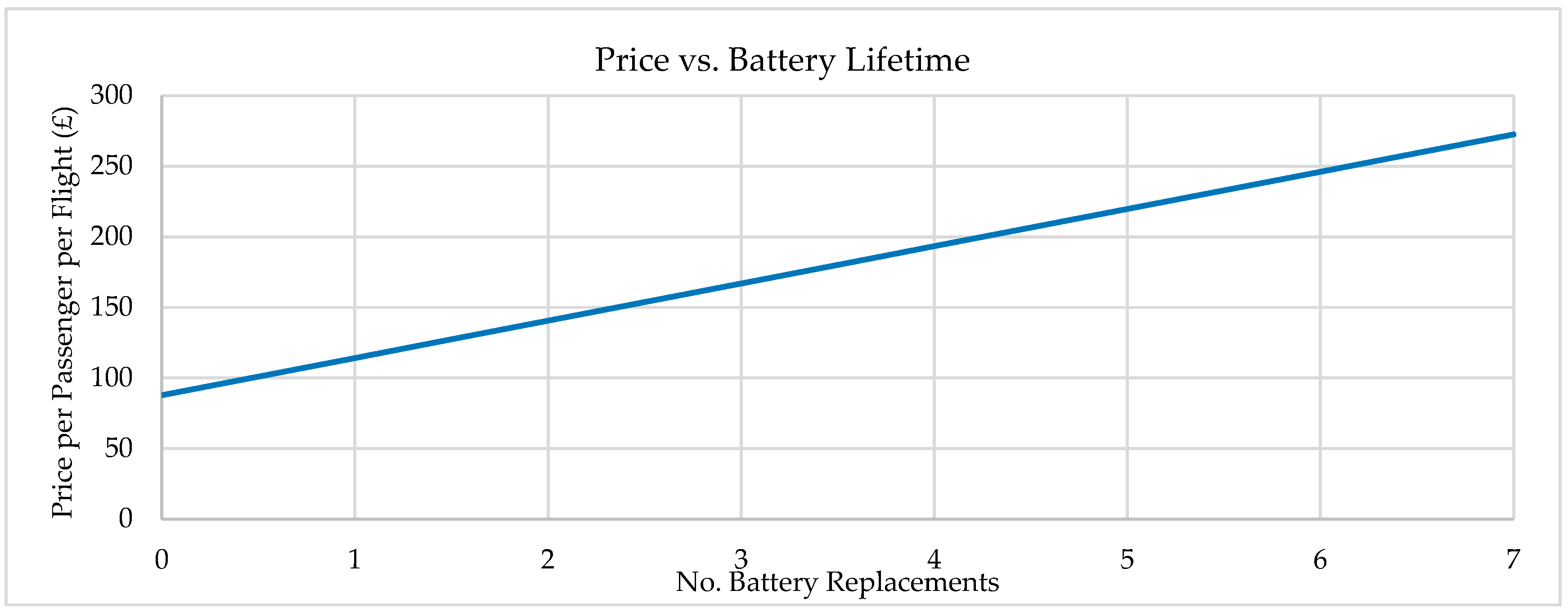1. Introduction
Global warming and CO₂ emissions are becoming increasingly prevalent issues in society with 92% of EU citizens considering climate change a serious problem in 2017 [
1]. With the increasing popularity of air travel, it is currently estimated that 2-3% of global CO₂ emissions are caused by the aviation industry [
2]. For the well-being of our planet and future generations, it is essential that environmentally sustainable aviation solutions are found. In 2007, The International Air Transport Association (IATA) stated a vision to eliminate greenhouse gas emissions from the aviation industry, this included an ambition to ‘build a zero-emissions commercial aircraft within 50 years’ [
3]. A key part of the design and implementation of any aircraft is an estimation of the direct operating costs (DOC) to ensure the aircraft is financially viable.
To understand the methodology for calculating DOC for a future all-electric aircraft, it is essential to first grasp how DOC is modelled for conventional aircraft. Lee et al. conducted a study to determine the DOC of all wide-body passenger aircraft currently in production across a large range of scenarios [
4]. The team then plotted DOC in cents per nautical mile per passenger against the number of passengers. The results clearly show the impact of different scenarios, such as the flight distance, on the cost per passenger. In order to reach the IATA’s zero-emission goal, electric aircraft are an attractive and sustainable alternative. A similar study, instead focusing on electric aircraft, would provide valuable insights into the reality of achieving this goal.
To date, several studies have aimed to find DOC of sustainable alternatives for a 19- seat aircraft. Shahwan investigated operating costs of Heart Aerospace’s ES-19 conceptual aircraft. He found that, for flights within 400km, the all-electric aircraft was 15-22% cheaper than a similar conventional aircraft over six regional routes [
2]. However it is worth noting that, although the ES-19 is designed as a 19-seat aircraft, Shahwan’s results reveal a passenger count of only eight. This is highly unlikely for commercial flights, even on regional routes.
Marksel et al. conducted a comparative analysis of DOC for a 19-seat aircraft powered solely by a hydrogen fuel cell and a traditionally powered aircraft. They plotted the total annual DOC against the years spanning from 2030 to 2050. The research found hydrogen fuel cells to become an increasingly more cost-effective substitute to conventional fuel sources [
5]. However, in 2030, the DOC analysis revealed a traditional 19-seat aircraft to be slightly cheaper than the hydrogen fuel cell alternative. Marksel at al. made no conclusions regarding the implications of this cost difference for the customer and only quantitative data of DOC for an entire year. The ultimate impact for customers may vary depending on the specific airline and its operational context.
Medeiros et al. developed a DOC model for their own conceptual design of an all electric 19-seat aircraft with a range of 500km. Their investigation indicated that the adoption of all-electric aircraft could reduce fuel costs by 81%. This resulted in an overall 39% reduction in DOC when compared to a conventional aircraft [
6].
When considering the DOC estimations of 19-seat all-electric and conventional aircraft, there is a significant disparity in the results obtained. Medeiros et al. reported a final percentage reduction in DOC nearly twice as high the results found by Shahwan (39% and 22% respectively). These considerable variations across studies show the clear need for further research to gain a more accurate understanding of the cost implications associated with all-electric aircraft.
Shahwan stated that only 2% of all domestic travel have a seating capacity of fewer than 20 passengers. On regional routes, the majority of aircraft carry a minimum of 50 passengers. Commonly utilised aircraft for short range commercial flights include the ATR-72, which typically seats 50-99 passengers, and the Boeing 737-800, designed for 150-199 passengers [
2]. From this it is clear that much more research needs to be conducted to find DOC for larger electric aircraft, operating on regional routes.
Ploetner et al. conducted a study focused on the Ce-Liner, a conceptual electric aircraft designed by Bauhaus Luftfahrt. The aircraft is designed to accommodate 190 passengers, with a range on 1700km [
7]. The report compared the DOC of the CeLiner to a projection of a Boeing 737-300 in the year 2035. Surprisingly, Ploetner et al. found a 0.8% increase in DOC when compared to the conventional Boeing 737-300. When looking at the breakdown of costs within the study’s DOC model, the Ce-Liner was found to have marginally less energy costs than the Boeing 737-300. This finding contradicts the results of other studies that have shown a substantial decrease in energy costs for electric aircraft. A recent study by Kafui Ayetor et al. highlighted that electric cars cost 83% less per mile compared to conventional cars [
8]. While this is not a direct comparison, it is consistent with results found in the studies concerning 19-seat aircraft, and therefore raises questions about the accuracy of the DOC model used by Ploetner et al.
Various methods exist for calculating DOC, these can differ among researchers. For example, Lee et al. employ the Association of European Airlines (AEA) method [
4], Shahwan compiled a method from the International Civil Aviation Organisation (ICAO) [
2], Medeiros et al. adapted a method from NASA [
6] and Marksel et al. took inspiration from the Lufthansa, AEA, Airbus Industries and Fokker methods [
5]. These models are primarily designed for large commercial aircraft, and their application to smaller scale aircraft may lead to inaccuracies [
5].
Shahwan, Medeiros et al. and Poetner et al. all built their DOC models around different conceptual aircraft, all of which were powered solely by a lithium ion battery. Lithium ion batteries have a higher energy density than other high quality rechargeable batteries, such as nickel-cadmium and nickel-metal-hydride [
9].
This literature review has highlighted a significant gap in the current literature regarding DOC for commercial use of electric aircraft. While there is a considerable amount of research around 19-seat aircraft, there are few studies for larger aircraft on regional routes. Furthermore, the literature review also brought to light a lack of definitive conclusions regarding the implications of electric aircraft usage on customers and how it may influence future ticket prices. After a review of current conceptual designs for electric aircraft, the Wright Spirit was chosen to review within this research. The design by Wright Electric is the only reasonably sized aircraft currently proposed. The aircraft is an adaptation of the BAe 146, seating 100 passengers, and will be utilized for 1-2 hour flights.
Based on the above review and research needs identified, the research questions of this paper are:
How will the DOC of the Wright Spirit compare to the BAe 146?
How will a shift to electric aircraft within commercial flight affect ticket prices in today’s market?
What are the governing factors when determining DOC?
2. Materials and Methods
The method used to calculate DOC in this study is largely based off that proposed by the Association of European Airlines (AEA). Unless stated otherwise, the equations are sourced from [
4].
2.1. Utilisation
The utilisation (U) of the aircraft is defined as the number of flights per year (Equation (1))
where the available hours per year (
) is assumed to be 3500 [
10], block time (
) is found by adding 0.25 to the flight time (
) [
4] and turnaround time (
) is assumed to be 1.5 [
6] unless stated otherwise.
2.2. Total Investment
The total investment (TI) is the sum of the cost of the aircraft and all initial spares (Equation (2)).
Where the manufacturers study price (MSP) is assumed to be £23,000,000 for the BAe 146 [
11,
12], the airframe spares (AFS) are estimated to be 10% of the airframe price (Equation (3)).
Where PSP is the propulsion system price and
is the number of propulsion systems. For the BAe 146 this is the engine price and is assumed to be £500,000. For the Wright Spirit, this is estimated using the following method. 8 MW of power is required for a 1-2 hour flight [
13]. Assuming the aircraft uses full power for 5 mins during take-off and the rest of the flight at a reduce power of 4MW.
At full power:
MWh, this is doubled to account for the power required in the event of go
around.
At half power:
MWh, for a 1 hour flight. If this is increased to 2 hours MWh.
Therefore a total of 5 MWh (9 MWh for 2 hour flights). Assuming a price of £1000 per 1 kWh [
14,
15], this equates to £5million per battery. The motor is assumed to cost £215,669 [
10,
16,
17]. With two motors per battery this adds to
$5950000 per propulsion system.
The spare propulsion units (SPU) are estimated to be 30% [
4] of the total propulsion system price (Equation (4))
2.3. Depreciation, Insurance and Interest
The depreciation (DEP), insurance (INS) and interest (INT) costs are all direct functions of the initial investment of the aircraft and its utilisation. Assuming a lifetime of 14 years [
4,
5], the depreciation (Equation (5)) represents the reduction in cost of the aircraft is it was sold at the end of its lifetime.
Assuming interest and insurance rates of 5% and 1% respectively [
5]:
2.4. Crew
The crew costs do not differ between the BAE 146 and the Wright Spirit. Total crew costs are the sum of cabin crew costs (CAC) and pilot costs (CPC) (Equation 8,9). As there are up to 100 passengers on board, only two cabin crew are required [
18]. According to British airways, the average cabin crew salary is £27/hour [
19] and the average salary of a first officer and a captain is £84.80/hour [
20].
2.5. Fees and Charges
The navigation charges (NAV) and landing fees (LAF) for commercial flight are governed by the country and airport for that flight. Navigation charges are calculated from Equation (10) [
21].
The maximum take-off mass (MTOM) is assumed to be 42 tonnes for both the Bae 146 and the Wright Spirit. At Heathrow airport the landing fee is £26.31 per passenger [
22]. Total fees and charges is the sum of navigation charges and landing fees.
2.6. Airframe Maintenance
Airframe maintenance costs (AMC) is the sum of airframe labour costs (AFL) and airframe materials (AFM) where:
Where the labour rate (
) of an aircraft engineer is £26.67/hour [
23] and the airframe weight is the operating empty weight [
24] of the aircraft minus the weight of the engines [
25]. This is equal to 2.13 tonnes.
The airframe price (AFP) is the MSP minus the price of all engines of the BAe 146. This is equal to £21,400,000 for both the BAe 146 and the Wright Spirit.
2.7. Propulsion System Maintenance
The propulsion system maintenance costs (PMC), is a function of propulsion system labour (PSL), propulsion system materials (PSM) and flight time (Equations (13)–(18)).
The same values are used for both the Wright Spirit and the BAe 146. There are 4 propulsion systems (
) and the thrust at sea level (
) is assumed to be 37.23kN [
25]. The bypass ratio (BPR), overall pressure ratio (OPR) and number of compressor stages (
) are assumed to be 5.7, 20 and 2 respectively [
26,
27].
2.8. Fuel/ Energy
The fuel costs for the BAE 146 are calculated using Equation (19).
Where the fuel burn per hour (
) is 4188lbs [
28] and fuel price is assumed to be £3 per gallon [
4].
The energy costs are calculated using the previous assumption that a 1 hour flight would require 5MWh of energy. Unless stated otherwise the costs of energy is assumed to be £65 per MWh [
29].
2.9. Direct Operating Cost
The total DOC is the sum of these components (Equation (20)).
3. Results
By utilising the methodology shown above for the two different power systems, the direct operating costs can be calculated. This allows the sensitivity of the model to varying the input costs to be evaluated.
3.1. Price vs. Flight Time
The DOC against flight length is shown in
Figure 1. Each flight time is shown for three variations of fuel/energy price for both the BAe 146 and the Wright Spirit. The medium fuel/energy prices are those stated in the method, low fuel/energy prices represent 50% of these and high fuel/energy prices represent 150% of the stated cost. In each case, the Wright Spirit is only limited to a flight length of 2 hours. The plot for the Wright Spirit when the aircraft is configured to its corresponding flight length is also shown, labelled ‘Wright Spirit – Limited Range’ (i.e. if the stage length is 1 hour then the battery capacity is set for 1 hour flights).
3.2. Comparison of DOC Components in 1 Hour Flights
A breakdown of all DOC components for the Wright Spirit compared to the BAe 146 (
Figure 2) shows the Wright Spirit has higher costs for most components except fuel/energy costs. The distribution of DOC components (
Figure 3) confirms this showing a much higher proportion of costs attributed to fuel for the BAe 146.
3.3. Effect of Charging Time and Battery Replacement
The charging time of the battery is included in the TAT within ‘utilisation’. A minimum charging time of ½ hour is used for analysis this is the minimum time required to clean the aircraft ready for the next flight, therefore a faster charging time would not affect the TAT. The breakdown of DOC costs for ½ hour charging time is compared with a 3 hour charging time (
Figure 4).
The lifetime of the Wright Spirit’s batteries are assumed to be 14 years throughout the results, a lifetime of 7-13 years would result in the batteries needing replacing once during the aircraft’s lifetime whereas a lifetime of 2 years would require 7 battery replacements overall. When calculating the DOC per passenger of a 1 hour flight against the charging time of the batteries (
Figure 5), a battery lifetime of 14 years is assumed. This means that zero battery replacements are included within these costs.
Additionally, when calculating the DOC per passenger of a 1 hour flight against the battery lifetime (
Figure 6), a charging time of 1.5 hours is assumed.
3.4. Comparison with Current Costs
To put the results obtained from the DOC model into context, a comparison against current ticket prices is shown in
Table 1. The prices show the range of tickets available on 5th October 2024, all flights are economy class with a small under-seat bag and a 23kg hold bag. Easy jet flights are flown to Gatwick and all others are Heathrow – all prices collected on 5/09/24.
4. Discussion
4.1. Comparison to Previous Literature
Building upon the research conducted by Lee et al, the initial step involved replicating their methodology to validate their findings, during which, a discrepancy in their methodology was identified. Specifically, their model calculated prices per flight for all DOC factors except airframe materials. To rectify this issue, the airframe maintenance equation was divided by U 1.5 , this produced consistent results. The assumptions outlined in the methodology section were applied to the refined model to assess the DOC of the Wright Spirit and a BAe 146.
The calculated cost for a 1-hour flight on the Wright Spirit was £108.91, increasing to £141.76 for a 2-hour flight. Notably, limiting the flight duration of the Wright Spirit to 1 hour led to a reduction in the price per passenger to £87.81, attributable to decreased power requirements and therefore decreased battery costs. In comparison, the DOC per passenger for 1-hour and 2-hour flights on a BAe 146 were £62.99 and £95.74, respectively. The analysis reveals a 73% increase in price for 1-hour flights on the electric aircraft (39% if restricted to 1-hour flights) and a 48% increase for 2-hour flights, compared to conventional aircraft costs. These findings indicate a significant discrepancy from previously documented values.
Shahwan and Madeiros et al. found an overall decrease in DOC of 22% and 39%, respectively, when comparing electric aircraft to conventional aircraft [
2,
6]. Both studies analysed a 19-seat aircraft operating on regional flights. While the flight durations are comparable to those in this study, the weight of their aircraft and consequently, their power requirements, are expected to be significantly lower than those of the Wright Spirit. The power requirements of the battery significantly influence its price hence, the aircraft price used in Shahwan and Madeiros et al’s studies is expected to be notably lower than the estimated price of the Wright Spirit, within this report.
Madeiros' study indicated that the electric aircraft reduced fuel/energy costs by 81% compared to the conventional aircraft. Similarly, in this study, the Wright Spirit was found to reduce fuel/energy costs by 83% (84% for 2-hour flights), when compared to the BAe 146. With depreciation, insurance and interest (all functions of aircraft price) collectively contributing to 59% of the Wright Spirit’s DOC, and 52% of the BAe 146’s DOC (
Figure 3), the increase in aircraft price is likely to have a large effect on the overall DOC. This underscores the notion that the discrepancies observed between my results, Shahwan, and Madeiros et al’s are likely attributed to differences in passenger capacity.
4.2. Analysis of Assumptions
Arguably, one of the most significant assumptions made was the battery price. Various methods were used to decide this. Alrashed et al. estimated a battery price of £285,342,500 [
10], this would increase the price per passenger, on a one-hour flight, to £1567. The method used to derive this estimate is not explicitly stated in the paper. While it mentions that the battery is hydrogen-powered, it fails to clarify whether the quoted price pertains to individual batteries or the total price of all batteries. If assumed to be the overall price, the cost per-passenger would decrease to £468. Additionally, the battery capacity remains unspecified. Consequently, this price estimate was disregarded.
Bradley et al. suggested a cost assumption for a lithium-ion battery of £228/kWh [
32]. This assumption significantly reduces the price per passenger to £67 for a one-hour flight (a 23% decrease). Bradley et al’s research was based on a hybrid electric aircraft, projected to fly by 2035. The battery used within their analysis had a capacity of 750Wh/kg, considerably lower than the proposed 1000Wh/kg battery for the Wright Spirit [
33]. Currently, lithium-ion batteries are priced around £1000/kWh [
14,
15]. Given that the analysis within this paper is based upon current pricing, a cost assumption of £1000/kWh has been used, with £228/kWh serving as a target for 2035.
For the comparison against current flights (
Table 1), it is assumed that the Wright Spirit can maintain a cruising speed equivalent to that of a conventional A320 aircraft. The current speed record for an all-electric aircraft stands at an average of 555.9 km/h over 3 km, implying that this speed was sustained for just under 20 seconds [
34]. Considering that Heathrow and Paris are approximately 348 km apart, assuming that take-off and landing collectively consume 15 minutes of flight time, the Wright Spirit would need to maintain an average speed of 348 km/h to align with the cost estimations provided in the table, this is within the record. Due to a lack of publicly available information regarding the Wright Spirit’s flight speed, this assumption has been made for simplicity. For comparison, a train ticket from Paris to Heathrow can cost as little as £60 and take just over 3 hours [
38,
39]. If a flight from Paris to Heathrow in the Wright Spirit were to take longer than my assumed duration of 1 hour and 15 minutes, it is probable that customers seeking a sustainable alternative to conventional air travel would opt for the train due to its significantly lower price.
4.3. Driving Factors
The DOC of the Wright Spirit is predominantly influenced by the battery price and the lifespan of the batteries. Varying battery costs dramatically changes the total costs (
Table 2). Notably, for a battery cost of £250/kWh, the cost per passenger, for a 2 hour flight, is just over £2 less than that of the BAe 146. For 1 hour flights, the DOC for the Wright Spirit is almost exactly £5 more than the BAe 146.
The lifetime of the battery heavily influences the overall cost, significantly outweighing the impact of battery price. The model, within this report, does not include battery replacements, therefore assuming each battery lasts for 14 years. However, a lifetime of 7-13 years would result in a single replacement during the aircraft’s 14 year lifetime. This effectively doubles the price of each battery and increases DOC by 30% (46% for 2 hour flights). Bradley et al. assumes a lifespan of 1000-5000 cycles [
32]. This variation has a dramatic change in DOC (
Table 3).
Another crucial factor is the charging time of the batteries. Longer charging times result in fewer feasible flights per day, with overall costs increasing by approximately £19.19 per hour of additional charging time (
Figure 5). This contrasts with an increase of £26.38 per battery replacement over the aircraft's lifespan (
Figure 6).
Notably, when extending the charging time, the only variable affected is the aircraft's utilisation. Consequently, only depreciation, insurance, interest, and airframe maintenance fluctuate as they are functions of utilisation. When increasing charging time from ½ hour to 3 hours, these factors collectively contribute to an extra 21% of the overall DOC (
Figure 4). The cost increase due to increased charging time may lead to research into removable battery packs, which allows charging and aircraft turn-around to be separated. However, the increase in battery infrastructure in this case has not been included in this study.
The results illustrate a linear relationship between flight duration and DOC (
Figure 1), when the flight capabilities do not vary. When the flight is configured to its flight length on the graph, the results are slightly curved. When examining the impact of fuel/energy costs on the comparison between electric and conventional DOC, it is clear that the electric aircraft is far less influenced by fluctuations in energy prices, compared to fuel prices for the BAe 146. Specifically, a 50% increase in fuel price per gallon led to a 16% rise in overall DOC for 2-hour flights, in conventional aircraft, whereas the Wright Spirit experienced only a 2% increase when energy prices were raised by 50%. Notably, both EasyJet and British Airways have undertaken fuel cost hedging for the year 2024 in response to escalating jet fuel prices, and their significant impact on overall DOC.
4.4. Effect on Ticket Prices
When comparing the results to current ticket prices, it is evident that, with the exception of Geneva, the estimated DOC for the Wright Spirit aligns with the ticket price range offered by British Airways (
Table 1). However, it is important to note that prices listed represent DOC only, and do not include other expenses that can impact ticket pricing. ‘Administration’ costs and ‘Marketing and Sales’ expenses amount to 10.4% and 8.5% respectively of overall operating costs [
37]. Furthermore, a significant determinant of ticket prices is the profit added by the airline. It is important to acknowledge that DOC also does not account for air passenger duty, which currently stands at £7 per passenger for domestic flights, and £13 for flights within and around Europe [
38]. These expenses are added to find a final ticket price, when comparing this to the British Airways price range, a maximum potential profit can be calculated for each route (
Table 4). An airline operating the Wright Spirit could potentially generate a total profit of up to £19,429 from a flight from Edinburgh to London, assuming all seats are filled (
Table 4).
Analysis of current ticket prices offered by Easy Jet and British Airways reveals that flight duration alone does not entirely dictate ticket pricing (
Table 1). When transitioning to all-electric aircraft for commercial flights, airlines may operate only selective routes to maintain low operating costs and maximise profits. Moreover, the appeal of sustainable air travel may prompt customers to be more receptive to higher ticket prices. A recent study indicated that individuals are willing to pay up to 12% more for sustainable alternatives to everyday products [
39], a trend likely applicable to air travel ticket prices.
5. Conclusions
The analysis conducted by this DOC model reveals a 73% overall increase in DOC from the BAe 146 to the Wright Spirit. However, a remarkable 82% reduction in fuel/energy costs indicates the potential viability of the Wright Spirit for future use. The battery price for the aircraft is likely to determine this. Assuming a quartering of battery prices, the Wright Spirit could obtain only a £5 increase in costs per passenger for 1- hour flights when compared to the BAe 146. Moreover, for 2-hour flights, the Wright Spirit emerges as over £2 cheaper than the conventional aircraft. The lifetime of batteries significantly impacts the DOC of the Wright Spirit, with an additional £26.38 per passenger, per 1-hour flight incurred for each battery replacement within the aircraft's lifespan. Furthermore, the charging time of batteries plays a pivotal role in determining the commercial viability of the Wright Spirit, with every hour of charging time adding £19.19 to the cost per passenger, per flight. Notably, the electric aircraft demonstrates resilience to fluctuations in energy prices, exerting minimal impact on 18 overall DOC. In the context of European routes, this research indicates that ticket prices would undergo negligible changes when compared to current rates. For example, a ticket from Paris to Heathrow on the Wright Spirit is projected to cost £136.10.
Future research could explore the effect of weight reduction during flight, considering the redundance of fuel in electric aircraft. Additionally, further analysis could include alternative conceptual designs, possibly targeting longer distances or accommodating larger passenger capacities. It is important to note that developing an electric aircraft is merely the first step towards commercial implementation. The infrastructure, such as charging stations, will inevitably add additional costs. Evaluating the implications of this investment would contribute to a comprehensive understanding of the role electric aircraft can play within the aviation industry.
Author Contributions
Conceptualization, P.W.; methodology, K.G.; formal analysis, K.G.; investigation, K.G.; data curation, K.G.; writing—original draft preparation, K.G.; writing—review and editing, P.W.; supervision, P.W. All authors have read and agreed to the published version of the manuscript.
Funding
This research received no external funding.
Data Availability Statement
All data generated is presented in this paper.
Conflicts of Interest
The authors declare no conflicts of interest.
References
- European Commission, Directorate-General for Climate Action, Going climateneutral by 2050 : a strategic long-term vision for a prosperous, modern, competitive and climate-neutral EU economy. Publications Office. 2019. [CrossRef]
- Shahwan K. Operating Cost Analysis of Electric Aircraft on Regional Routes. Department of Science and Technology Linkoping University. 2021.
- International Air Transport Association. A global approach to reducing aviation emissions. 2014.
- Lee M, Li LKB, Song W. Analysis of direct operating cost of wide-body passenger aircraft: A parametric study based on Hong Kong. Chinese Journal of Aeronautics. 2019; 32(5): 1222-1243. [CrossRef]
- Marksel M, Brdnik AP. Comparative Analysis of Direct Operating Cost: Conventional vs. Hydrogen Fuell Cell 19-Seat Aircraft. Sustainability in Aviation. 2023; 15(14): 11271. [CrossRef]
- Medeiros M, Monjon M, Monzu Freire C. Conceptual Design and Operating Costs Evaluation of All-Electric Aircraft for Regional Aviation. AIAA Propulsion and Energy Forum. 2020; 24(28). [CrossRef]
- Ploetner KO, Schmidt M, Baranowski D, Isikveren AT, Hornung M. Operating Cost Estimation for Electric-Powered Transport Aircraft. 2013 Aviation Technology, Integration and Operations Conference; August 12-14; Los Angeles. American Institute of Aeronautics and Astronautics; 2013. [CrossRef]
- Kafui Ayetor G, Edem Dzebre DK, Mensah LD, Boahen S, Owura Amoabeng K, Kwaky Tay GF. Comparing the Cost per Mile of Electric Vehicles and Internal Combustion Engine Vehicles in Ghana. Transportation Research Record: Journal of the Transportation Research Board. 2022; 2677(5). [CrossRef]
- Adu-Gyamfi BA, Good C. Electric aviation: A review of concepts and enabling technologies. Transportation Engineering. 2022; 9: 2666-2691. [CrossRef]
- Alrashed M, Nikolaidis T, Pilidis P, Jafari S. Utilisation of turboelectric distribution propulson in commercial aviation: A review on NASA’s TeDP concept. Chinese Journal of Aeronautics. 2020; 34(11): 48-65. [CrossRef]
- Aerocorner. British aero BAE 146 - price, Specs, photo gallery, history [Internet]. [cited 2024 Mar 11].
- Hardiman J. Quirky quadjet: 40 years of the british aerospace 146 [Internet]. 2021 [cited 2024 Mar 11].
- Wright Electric [Internet]. [cited 2024 Mar 11]. Available from: https://www.weflywright.com/motor.
- Battery storage [Internet]. 2024 [cited 2024 Mar 11].
- Manager S. 2023 breakdown: Solar panel battery costs in the UK [Internet]. 2023 [cited 2024 Mar 11].
- Alrashed M, Nikolaidis T, Pilidis P, Alrashed W, Jafari S. Economic and environmental viability assessment of NASA’s turboelectric distribution propulsion. Energy Reports. 2020 Nov;6:1685–95. [CrossRef]
- Felder JL. NASA N3-X with Turboelectric Distributed Propulsion. Lecture presented at; Ohio; 2024.
- Ahlgren L, Staff SF. How many crew are required on an aircraft? [Internet]. 2022 [cited 2024 Mar 11].
- British Airways. Cabin crew [Internet]. [cited 2024 Mar 11].
- Academy A by LA. How much does a pilot in the UK earn? [Internet]. 2020 [cited 2024 Mar 11].
- The Civil Aviation Authority. Transport Act 2000, Charges for Air Services, (Navigation Services Charges) Specification 2023. 2023.
- Ellichipuram U. Heathrow ordered to lower landing charges until 2026 [Internet]. 2022 [cited 2024 Mar 11].
- Licenced+Aircraft+engineer salary in United Kingdom - average salary [Internet]. [cited 2024 Mar 12].
- British aerospace BAE-146 [Internet]. [cited 2024 Mar 12].
- Rauch D. Design Study of an Air Pump and Integral Lift Engine ALF-504 Using the Lycoming 502 Core. U.S. Department of Commerce; 1972.
- Lycoming ALF-502 [Internet]. [cited 2024 Mar 17]. Available from: https://www.aarg.com.au/alf502.html.
- Lycoming T55 - Wikimili, the free encyclopedia [Internet]. 2021 [cited 2024 Mar 17]. Available from: https://wikimili.com/en/Lycoming_T55.
- Fuel consumption table [Internet]. 2017 [cited 2024 Mar 12].
- CMF. CMF LG Energy Weekly Report 30th January 2024.
- Book cheap flights and Holidays [Internet]. [cited 2024 Sep 5].
- British Airways: Book flights, holidays, City Breaks & Check in online [Internet]. [cited 2024 Sep 6].
- Bradley MK, Droney CK. Vol. 2, Subsonic Ultra Green Aircraft Research: Phase II – Volume II – Hybrid Electric Design Exploration. NASA; 2015 p. 72–72.
- Wright Battery Program [Internet]. We Fly Wright. 2023 [cited 2024].
- ‘spirit of innovation’ stakes claim to be the world’s fastest ... [Internet]. 2021 [cited 2024 Mar 14].
- Eurostar, Train search [Internet]. [cited 2024 Mar 17].
- Trainline-Buy train tickets for travel in the UK and Europe [Internet]. [cited 2024 Mar 17]. Available from: https://www.thetrainline.com/.
- Withey P. Aerospace Power Systems2024 Week 8 Lecture Slides.
- HM Revenue & Customs. Rates for air passenger duty [Internet]. 2023 [cited 2024 Mar 14].
- Faelli F. Consumers say their environmental concerns are increasing due to extreme weather; study shows they’re willing to change behavior, pay 12% more for sustainable products [Internet]. 2023 [cited 2024 Mar 14].
|
Disclaimer/Publisher’s Note: The statements, opinions and data contained in all publications are solely those of the individual author(s) and contributor(s) and not of MDPI and/or the editor(s). MDPI and/or the editor(s) disclaim responsibility for any injury to people or property resulting from any ideas, methods, instructions or products referred to in the content. |
© 2024 by the authors. Licensee MDPI, Basel, Switzerland. This article is an open access article distributed under the terms and conditions of the Creative Commons Attribution (CC BY) license (http://creativecommons.org/licenses/by/4.0/).
